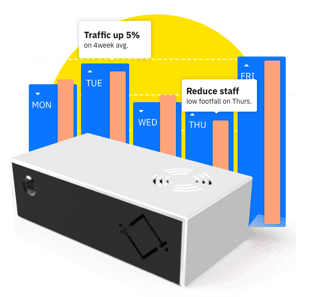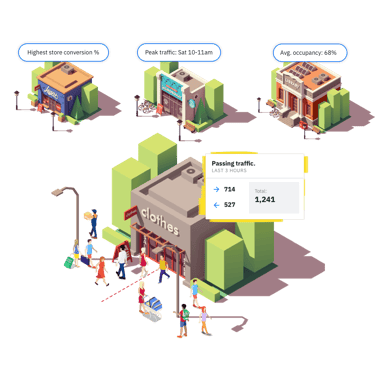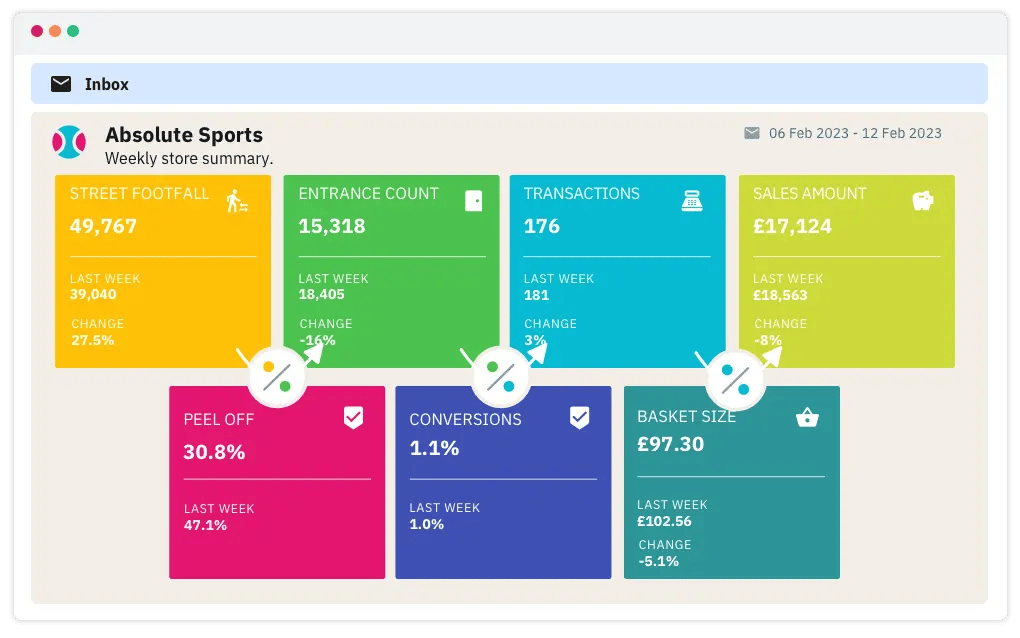One of the biggest differences between optimization in online and physical retail spaces is the limitation of collecting and processing visitor and customer data. That being said, we all know how valuable insights from in-store footfall and conversion rates can be, with most retailers relying heavily on these metrics to make important operational decisions. However, what we have found overlooked is how combining in-store footfall data, street footfall data, along with sales metrics, allows retailers to produce a similar funnel-style view to that of an online store.
The Metrics
Let's quickly review the various elements we’ll be looking to combine to create our digital funnel. We start with in-store footfall, collected using a highly accurate camera-based system powered by artificial intelligence. This data, of course, is then combined with sales data and allows for the calculation of an in-store conversion rate, which I’m sure you’re already familiar with (if not click here to see our breakdown of conversion in retail).
The next ingredient is street footfall data, collected by our globally patented side-firing cameras. These have many advantages over other collection methods such as superior accuracy to wifi-based systems and, when compared with aggregate footfall data that is sometimes provided at the street or shopping center level, they are able to continuously measure the number of people who pass by your specific store, thus better representing the opportunity you had to draw in potential customers.
Taking then both the in-store and street counts, we calculate a street-to-store conversion rate or ‘capture rate’. This can metric is especially useful if, among other things, you’re looking to drive footfall to your store we detail exactly why in this article, but in short it allows you to understand how well you’re location is converting passers-by into store visitors in a way that isn’t possible with footfall alone. The following article gives more information on how people count is used to improve store performance.
Lastly, we take again the number of sales and the revenue and calculate the average basket size which adds important context to the in-store conversion rate.
The Digital Funnel
Each of these metrics alone can of course be utilized to achieve help achieve a range of goals, but combining them is where we feel they really shine.
Now let's consider the journey of a prospective customer. First is the passerby who we want to draw into the store, here we look at street footfall and assess how well we’re converting passersby into visitors with our street-to-store conversion rate. Then once people are in-store we can use our in-store conversion rate to determine how the store as a whole is doing in converting visitors into paying customers. Lastly, we use the average basket value to see better understand the conversion rate and sales in relation to the revenue. At each critical point in the customer journey, we now have a clear metric to compare our performance. Their experience before they enter, while they’re in-store, and how much they spend.
By tracking and analyzing these metrics, we can begin to attempt to understand what might influence each stage of the funnel, helping us to improve, perhaps in areas in which our performance is less than satisfactory. Then, once we’ve taken action, we’re able to reliably assess the impact of our efforts.
For example, if a retailer has a low street-to-store conversion rate they may decide to refresh their window displays or run a local marketing campaign in an attempt to boost the proportion of people visiting the store and observe any change there might be in the capture rate following their action. Or if their in-store conversion rate seems to be lower than expected, they may choose to change some of the stock in the store or to provide additional training for the store's sales staff, this time observing the effect on the conversion rate. In general, having this digital view of the store's performance throughout the customer's journey has set up the framework for store optimization.
Unsurprisingly though, accounting for all these metrics can be complex and difficult to track, especially if the technology is split over a number of vendors or when looking at a collection of stores. With that in mind, in order to make this data easily comprehensible we’ve created a reporting system specifically designed to clearly present all the relevant data in this funnel view for each store individually or for analysis across a portfolio of stores. Ultimately ensuring both maximum visibility and maximum actionability of the data. 
Recent Articles
How real-time footfall data helped a Telco Franchisee drive a 20% increase in revenue
Duncan Mann | Oct 2024
Background: the importance of sales conversion rate
Read moreCase Study: How fashion retailer GOOD uses the HoxtonAi Retail Report to improve accountability and increase conversion across their stores.
Owen | Jun 2023
“The retail report has been a game-changer. Each week, we discuss the footfall and conversion ...
Read moreOn the accuracy of retail footfall counters
Owen | May 2023
In retail, footfall-related metrics have become cornerstone data points used to track various ...
Read moreThe OKR goal setting framework: how to drive success in retail
Owen | Apr 2023
At HoxtonAi, we speak to hundreds of retailers about their store management, data requirements and ...
Read moreHow combining different types of footfall data can build a digital view of physical stores
Owen | Apr 2023
One of the biggest differences between optimization in online and physical retail spaces is the ...
Read moreWhy footfall isn't the end-all. What to do about the retail data gap.
Owen | Apr 2023
In our experience, we’ve found that most retailers are familiar with the idea of monitoring ...
Read moreThe Main Challenges for Retailers in Fully Leveraging Footfall Data
Owen | Mar 2023
In today's digital age, data has become a valuable asset for businesses looking to optimize their ...
Read moreWhat We Talk About When We Talk About Retail Footfall
Owen | Mar 2023
The soft side of cold, hard data We’ve released content on the ‘hard’ aspects of using data to ...
Read moreTop 6 Essential KPIs & Metrics in Retail
Owen | Mar 2023
As retail technology has evolved, we have found better ways to measure, track and compare ...
Read moreWhat is Conversion in Retail? And How to Measure it in a Physical Store?
Owen | Mar 2023
What is a conversion rate? A conversion rate is typically considered to be the percentage of people ...
Read moreHow to use Footfall Analytics to Improve Store Performance
Duncan Mann | Mar 2023
Before we get started, for a quick reminder of what 'people count' and 'footfall' mean, check out ...
Read moreWhat We've Found Analysing Footfall Data in Retail
Duncan Mann | Mar 2023
5 Trends We've Noticed... "At HoxtonAi, we work with customers to ensure their data is high ...
Read moreClosing the data gap between online and physical retailing
Owen | Mar 2023
As shoppers continue to return to the high street post-pandemic, physical stores need to catch up ...
Read moreAn Introduction to People Counting in Retail
Owen | Mar 2023
What is people counting? Simply put, people counting is the act of counting the number of people ...
Read moreCase Study: How Center Parcs Use Occupancy Data To Drive Better Guest Experiences.
Duncan Mann | Aug 2022
We initially trialled the HoxtonAi solution on a small scale to ‘kick the tyres’ and see if it’s a ...
Read more